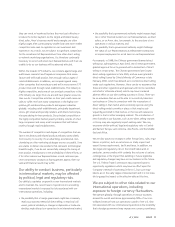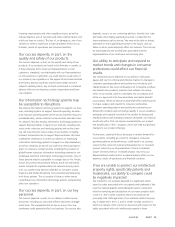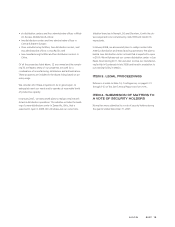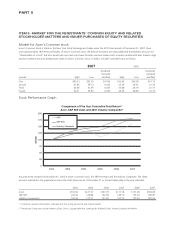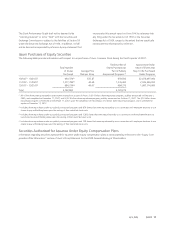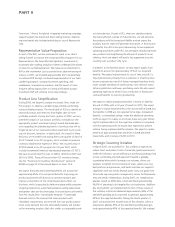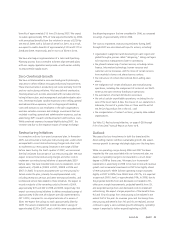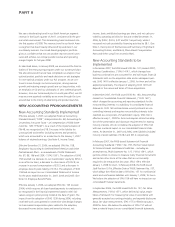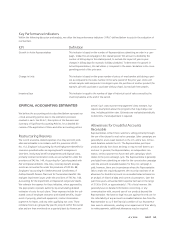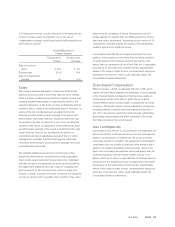Avon 2007 Annual Report Download - page 26
Download and view the complete annual report
Please find page 26 of the 2007 Avon annual report below. You can navigate through the pages in the report by either clicking on the pages listed below, or by using the keyword search tool below to find specific information within the annual report.PART II
Tomorrow,” Avon’s first global, integrated marketing campaign,
supporting both the brand and direct selling channel. Advertis-
ing investments also included advertising to recruit Representa-
tives.
Representative Value Proposition
As part of the RVP, we also continued to invest in our direct-
selling channel to improve the reward and effort equation for our
Representatives. We have allocated significant investments in
proprietary direct selling analytics to better understand the drivers
of value for our Representatives. We measure our investment in
RVP as the incremental cost to provide these value-enhancing ini-
tiatives. In 2007, we invested approximately $121 incrementally
to enhance RVP through continued implementation of our Sales
Leadership program, increased incentives spending, web
enablement, improved commissions, and the launch of more
frequent selling opportunities in Central and Eastern Europe.
Investing in RVP will continue to be a key strategy.
Product Line Simplification
During 2006, we began to analyze our product line, under our
PLS program, to develop a smaller range of better performing,
more profitable products. The overall goal of PLS is to identify an
improved product assortment to drive higher sales of more
profitable products. During the fourth quarter of 2007, we com-
pleted the analysis of our product portfolio, concluded on the
appropriate product assortment going forward and made deci-
sions regarding the ultimate disposition of products that will no
longer be part of our improved product assortment (such as sell-
ing at a discount, donation, or destruction). As a result of these
decisions, we recorded costs during the fourth quarter of 2007 of
$103.7 related to our PLS program, which includes incremental
inventory obsolescence expense of $99.2. We incurred costs of
$187.8 related to our PLS program for full year 2007, which
includes incremental inventory obsolescence expense of $167.3.
We have incurred total PLS costs of $269.2 ($187.8 in 2007 and
$81.4 in 2006). There will be no further PLS inventory charges.
See the “Provisions for Inventory Obsolescence” section of
MD&A on page 24 of the Annual Report on Form 10-K.
We expect that sales and marketing benefits will account for
approximately 85% of our projected benefits. Improving our
product assortment will allow us to increase exposure and
improve presentation of the remaining products within our
brochure, which is expected to yield more pleasurable consumer
shopping experiences, easier Representative selling experiences,
and greater sales per brochure page. A second source of benefits
from PLS results from “transferable demand.” Transferable
demand refers to the concept that when products with
redundant characteristics are removed from our product assort-
ment, some demand from the eliminated products will transfer
to the remaining products that offer similar or comparable prod-
uct characteristics. As part of PLS, when we identify products
that have sufficient overlap of characteristics, we will eliminate
the products with the lowest profitability and we expect the
products that we retain will generate more profit. A third source
of benefits from PLS is less price discounting. As we implement
operating procedures under PLS, we anticipate introducing fewer
new products and lengthening the lifecycle of products in our
offering, which we expect will lead to less aggressive price dis-
counting over a product’s life cycle.
In addition to the benefits above, we also expect supply chain
benefits to account for approximately 15% of our projected
benefits. We expect improvements to cost of sales once PLS is
fully implemented, primarily from a reduction in inventory obso-
lescence expense as a result of better managed inventory levels,
lower variable spending on warehousing, more efficient manu-
facturing utilization and lower purchasing costs. We also expect
operating expenses to benefit from a reduction in distribution
costs and benefits to inventory productivity.
We expect to realize annualized benefits in excess of $200 by
the end of 2009, with a full year of benefit in 2010. We expect
to begin to realize initial benefits in the second half of 2008, but
the benefits in 2008 are not expected to be large. Annualized
benefits, or annualized savings, mean the additional operating
profit we expect to realize on a full-year basis every year follow-
ing full implementation of the respective initiative as compared
with the operating profit we would have expected to achieve
without having implemented the initiative. We expect to realize
benefits of approximately $40 and $120 in 2008 and 2009,
respectively, and in excess of $200 in 2010.
Strategic Sourcing Initiative
In March 2007, we launched SSI. This initiative is expected to
reduce direct and indirect costs of materials, goods and services.
Under this initiative, we are shifting our purchasing strategy from
a local, commodity-oriented approach towards a globally-
coordinated effort which leverages our volumes, allows our
suppliers to benefit from economies of scale, utilizes sourcing
best practices and processes, and better matches our suppliers’
capabilities with our needs. Beyond lower costs, our goals from
SSI include improving asset management, service for Representa-
tives and vendor relationships. During 2007, we completed an
analysis, based on 2006 data, which identified approximately
$4,000 of spending to be targeted for cost reductions. Addition-
ally, during 2007, we implemented the first of three waves of
this initiative, which has addressed approximately 38% of the
identified spending and is expected to generate approximately
45% of the expected benefits. During the fourth quarter of
2007, we launched the second wave of this initiative, which is
expected to address 45% of the identified spending and gen-
erate approximately 40% of the expected benefits. We realized



